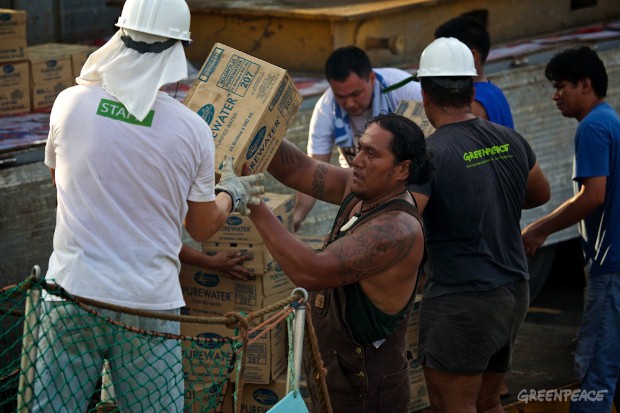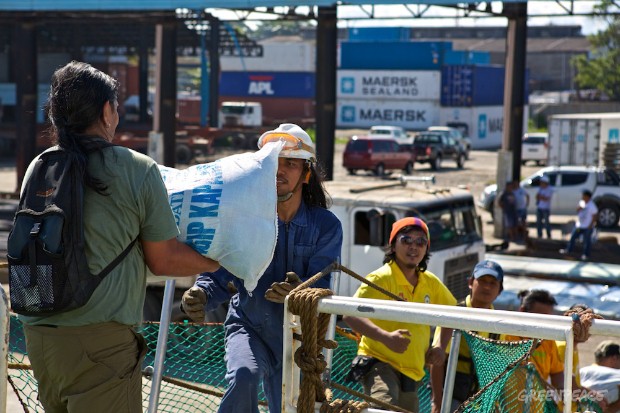Greenpeace ship the Esperanza transported relief goods to communities in the Philippines devastated by typhoon Pablo (Bopha). Mark Dia, our Regional Oceans Campaigner, is currently serving as our onboard team leader for our Pablo Response mission.
Blogpost by Mark Dia
He sent us the following update from the field just before the Esperanza made landfall in Davao City on 11 Dec. 2012.

Crew of the Greenpeace ship, M/Y Esperanza, and volunteers unload supplies from the Esperanza at the port Sasa km10 Wharf in Davao City. The ship transported relief goods from the Department of Social Welfare and Development (DSWD), Save the Children, and ABS-CBN Foundation to the communities devastated by typhoon Pablo (Bopha).
It’s 2230, and I’ve just come back from the bridge of the Esperanza, drawn by the gleam of a light show on our starboard. Up above was the Milky Way, and I was telling Steve, our photographer, that there was no way you could see that many stars in Manila, with all the light pollution.
That’s when it struck me: the coast was pitch black.
We had a look at the electronic map, and we realised that we were just off the coast of Cateel, Boston and Baganga, the three hardest hit coastal towns in Mindanao. Somewhere out there, there are tens of thousands of people without electricity, without shelter, without water, without food, without loved ones, all of which were violently taken by 260 kilometer per hour winds.
Most of these people have not experienced a typhoon in their lifetimes, as they never really pass here, yet they were hit with the strongest tropical cyclone to ever make landfall in Mindanao, Southern Philippines. Unfortunately, this will be the world’s new normal if manmade climate change were to continue unabated.
Going back to the bridge, among the iridescent glow of the instruments I notice that we are now going 16 knots. The Esperanza had been pushing hard to get to Davao and offload the 55 tons of goods that we loaded in Manila. Nearly all of the crew members I spoke to have not seen the Espy going this fast, let alone this fast for so long. But these are unusual circumstances, and we have all been pushing hard since the weekend.
Tomorrow when we dock, we will have done in three days what normally takes five by ship, and which would have taken even longer had we not been able to load up so fast. By last inventory we have enough supplies to bring some relief to about 10,000 to 15,000 families for a little while.
It seems like a lot, but in times like these, you always wish you could do more.




